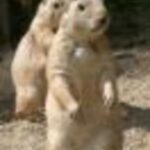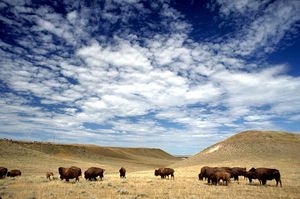I am writing to tell you of this great time of prosperity for us. Our numbers are many and our food is plentiful. It is a good time to be a bison in the Americas. The plains stretch for farther than the eye can see and it takes us close to a month to travel from our summer to our winter home. There are many animals living here and we all cohabitate peacefully, at least from my end of the spectrum. All I’m concerned with is finding sweet prairie grasses for me and my family to graze on. That and the safety of my children is what I live for and what I’d die for. As a bison I can be somewhat unpredictable if you don’t know me. Some would even say violent, but only when I feel threatened or when someone near me is in danger.
I don’t foresee any changes in our way of life. The plains have always been wide open expanses for us to use and enjoy. We try to be respectful of the lands traveling nearly 3 miles a day to ensure we are not over grazing the sweet grasses of our home. Twice a year we take a great trip north (or south) in order to follow the sun and the food.
It will soon be time for us to make the long journey from the high country to the warmer low country and I can’t help but notice how many new calves we have this season. With very few predators willing to come in contact with our horns we are free to live and roam wherever we’d like. For those that do, our thick and matted fur protects our necks and our lives. Recently, I have noticed a few strange animals on the plains. Animals that walk on two legs, I guess they do this because it makes them look much taller than they really are. They are virtually hairless and seem to be relatively weak. These animals have sticks that they throw at great speeds that are able to pierce the hides of my family. Last month one of my very best friends fell to these beasts, but I watched as they utilized her meat for nourishment and her beautiful pelt and horns as tools and clothing. These animals kill but seem very grateful for the life we bring. I am glad to know that she is still bringing happiness to someone. This does not mean that I am not sad to see one of my herd fall to these beasts, but I do not believe that the small group I saw would be able to have a lasting affect on our populations.
Although I usually stick to my herd of about 60 or 70, during the migration we meet up with hundreds of other herds totaling about 60 million bison in all. I love to watch the “river” of brown fur making its way across the well worn migration routes. The thundering hooves can be heard from miles away and the ground shakes from our combined weight. It really is an amazing sight to behold. You can meet up with old friends and lovers and you can talk about what happened during the spring and summer seasons. Calves are born, lessons are learned, and sometimes friends may die, but it’s always nice to get an update.
No matter the chatter we are headed southward for two reasons, warmer weather and finding a mate. Last year, during the season, we had a young bull that fought with many older males but lost each time. Perhaps this year he will succeed to bear some young. It is always fun to watch the bellowing and charging males butt heads with one another. Both of them trying to prove they’re the better mate, or who is the stronger of the two. It’s important to me, as a mother, to ensure that my calves will have the strongest genes possible. I want them to survive and prosper, not get picked off for being weak. I believe that we all want future generations to be stronger and better than we were.
I’m excited for the winter grasses and for the mating rituals of spring but mostly I’m excited for you. I can’t imagine a situation where you would not be prosperous. The land gives just as much as you need and as long as you respect the land and give back what you can you should live a long and healthy life, as I expect I will.
Yours,
Blackfoot Bison



